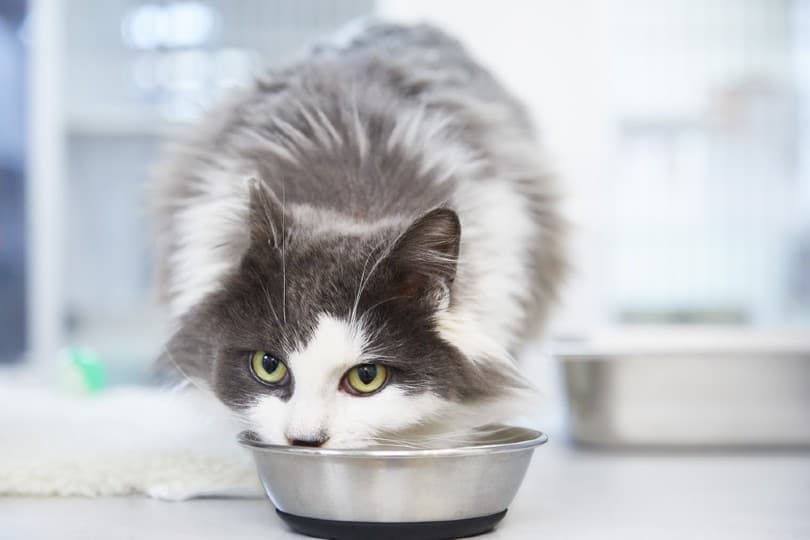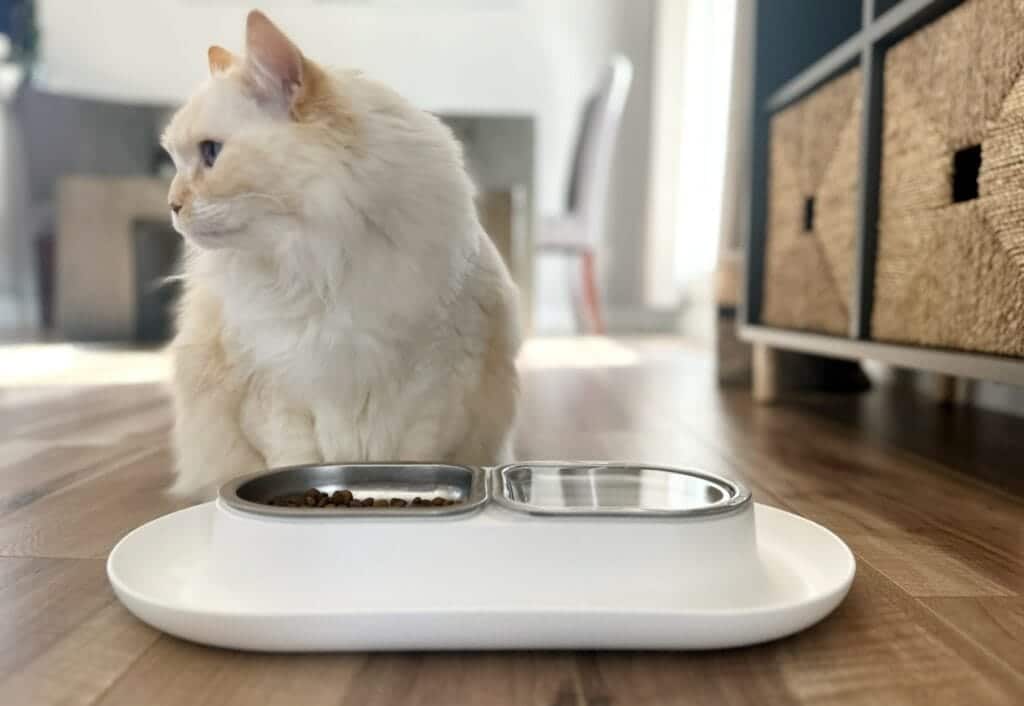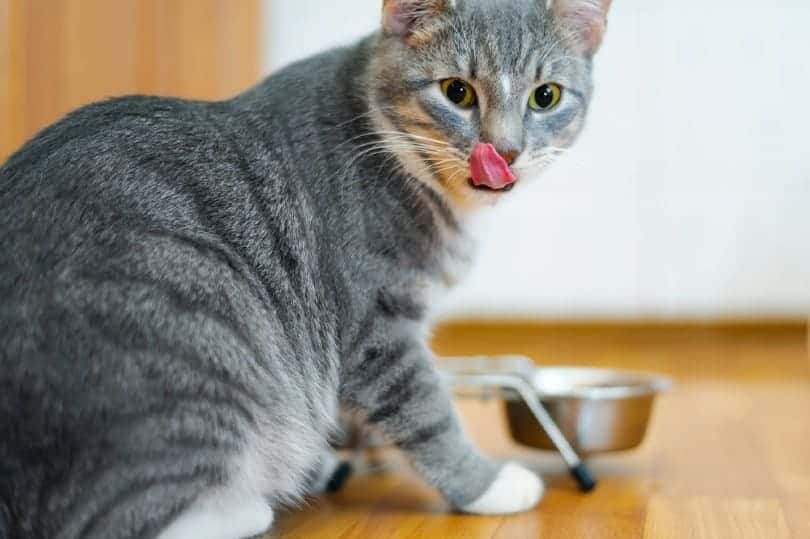

A Quick Comparison of Our Favorites in 2024
| Image | Product | Details | ||
|---|---|---|---|---|
| Best Overall |

|
Hepper Nom Nom Spill Proof Bowls |
|
CHECK PRICE |
| Best Value |

|
URPOWER Stainless Steel Bowl |
|
CHECK PRICE |
| Premium Choice |

|
K&H Thermal Stainless Steel Bowl |
|
CHECK PRICE |
| Best for Kittens |

|
Loving Pets Bella Bowls |
|
CHECK PRICE |

|
Ethical Pet Stainless Steel Cat Bowl |
|
CHECK PRICE |
The 10 Best Stainless Steel Cat Bowls
1. Hepper Nom Nom Spill Proof Elevated Bowls – Best Overall

| Color: | White |
| Dimensions: | 9 x 16 x 2 inches |
| Weight: | 1.7 pounds |
One characteristic that immediately stands out with the Hepper Nom Nom bowls is that the bowls are shallow and wide with a tray underneath. This design keeps your cat’s whiskers out of their food, and the tray catches all the bits that fall from messy eaters. You might not know this, but most cats don’t like their whiskers rubbing up against the side of the bowl.
This stainless steel bowl is completely chew-proof, including the tray. You won’t ever have to deal with pieces breaking off and risking them choking. These stainless steel bowls are also easy to clean since each side snaps out of the tray and is dishwasher safe. Unfortunately, because the sides are so short, spills are more likely to occur.
Regardless, we’ve found that the Hepper Nom Nom brand provides the best overall stainless steel cat bowls on the market.
At Catster, we’ve admired Hepper for many years and decided to take a controlling ownership interest, so that we could benefit from the outstanding designs of this cool cat company!
- Chew-proof material
- Tray catches spill
- Easy to clean
- Whiskers don’t hit the bowl
- Short walls
2. URPOWER Stainless Steel Bowl – Best Value

| Color: | Black, grey, red, blue |
| Dimensions: | 5.6 x 9.6 x 10.6 inches |
| Weight: | 1.61 pounds |
While these bowls are marketed for dogs, they are still a great option for cats. There are two stainless steel bowls that sit on top of a silicone mat. The mat prevents the bowls from sliding or skidding on the floor while your pets eat. The mat is also large enough to catch even the messiest spills.
Both bowls are made from rust-resistant stainless steel that is dishwasher-safe. Each bowl also holds a good amount of food for your cats, regardless of their size. However, it isn’t the best choice for kittens. With durability and functionality in mind, these products are among the best stainless steel cat bowls for the money.
- Multiple colors
- Silicone mat prevents spills
- Non-slip support
- Too large for kittens
3. K&H Products Thermal Stainless Steel Bowl – Premium Choice

| Color: | Steel |
| Dimensions: | 13 x 13 x 3.5 inches |
| Weight: | 2.93 pounds |
While not everyone is comfortable splurging on cat bowls, some people prefer to buy the best of the best for their cats. The K&H Products thermal bowl is the premium choice of all water bowls. This stainless steel bowl is electronic and controlled by a thermostat. The cord won’t get wet since it wraps inside of the steel, plus they are chew-proof to protect your cats. It is also 5 feet long so that it can reach most places in your house.
This bowl is designed to prevent water from freezing, so if you keep a water bowl outside for your cats during the winter, this is a great way to ensure that they always have a steady supply of water. The biggest downfall to this is the high price, but it’s worth it for some cat owners.
- Heats water
- Long cord
- Ideal for outdoor cats
- Chew-proof cord
- Expensive
4. Loving Pets Bella Bowls– Best for Kittens

| Color: | Grape |
| Dimensions: | 5.5 x 5.5 x 2 inches |
| Weight: | n/a |
Finding food and water bowls for kittens is a bit more challenging. Kittens are much smaller and it’s easier for them to make messes. You want something that allows them to get to their food without getting it all over the place. The Loving Pets Bella bowls are a great option for kittens. Although there is only one bowl included, it is an affordable product. This bowl comes in many different sizes and has high sides, so your kitten won’t make a mess. The outside has a poly-resin to give the bowl a cute design instead of being plain. The rubber base is also removable to make it easier to clean.
- Dishwasher safe
- High sides
- Available in different sizes
- Rubber base
- Cheap
- Only one bowl
- Outer design wears over time
5. Ethical Pet Stainless Steel Cat Bowl

| Color: | Steel |
| Dimensions: | 5.5 x 5.5 x 5.5 inches |
| Weight: | .5 pounds |
While this bowl is only suitable for those who use a kennel, it’s still a great product to have. This cat bowl clips directly onto any kennel and prevents it from tipping over inside the space. You can also adjust it to sit higher or lower in the kennel to keep food and water from mixing.
This cat bowl is dishwasher-safe, CPA-free, and lead-free. It is small but still ideal for when you do have to put your cat up.
- Won’t tip over
- Hooks to all metal kennels
- Dishwasher safe
- BPA and lead-free
- Small
- Only suitable for kennels
6. Platinum Pets Stainless Steel Bowl

| Color: | Red, blue, teal, purple, black, pink |
| Dimensions: | 11.75 x 11.75 x 2.75 inches |
| Weight: | 1.12 ounces |
Even though we enjoy the benefits of stainless steel, we also sometimes want something that adds a bit of color to the space. This stainless steel cat bowl comes in many different colors to brighten up the room. Although it is good for cats of all sizes, some larger breeds might enjoy an even bigger bowl better.
The pawprint design is attractive, but don’t let it distract you from its other good features. This bowl has a silicone base to keep the bowls from sliding or tipping over. However, the rubber bottom does come off easily, and the stainless steel itself isn’t the highest quality. Still, this is a nice option if you’re looking for steel bowls that are attractive and affordable.
- Unique design
- Dishwasher safe
- Rubber bottom
- Bottom comes off easily
- Lower stainless steel quality
7. Our Pets Stainless Steel Cat Bowl

| Color: | Silver, stainless steel |
| Dimensions: | 5.33 x 5.33 x 1.14 inches |
| Weight: | 1 pound |
Although a little pricier than other bowls, this one is made out of heavyweight stainless steel that makes it extra durable. They are shallow but also very wide to keep your kitty’s whiskers from being disturbed. The rubber bottom also keeps it from sliding around. Although they do claim this bowl is dishwasher safe, there are reports of the rubber bottom melting. It only doesn’t hold a full 8 ounces.
- Heavyweight
- Won’t rub on whiskers
- Non-slip base
- Doesn’t hold a lot of water
- Rubber melts in dishwasher
8. Peggy11 Non-slip Stainless Steel Cat Bowl

| Color: | Blue, grey |
| Dimensions: | 5.9 x 5.9 x 2.2 inches |
| Weight: | 4.66 ounces |
This Peggy11 stainless steel cat bowl comes in a set or as individual bowls. They are entirely stainless steel with the bottom coated in silicone to protect your floors. The rubber is even dishwasher safe on this one. However, they are very lightweight and are easy for cats of all sizes to tip over and move around.
- Purchase as set or individual
- Dishwasher safe
- Rubber bottom
- Lightweight
- Tips over easily
9. Dr. Catsby Stainless Cat Bowl

| Color: | Stainless steel |
| Dimensions: | 7.25 x 7.25 x 1.25 inches |
| Weight: | 13.62 ounces |
This cat bowl looks high-quality from the moment you set eyes on it. It features a unique design with a shallow bowl that doesn’t have any walls to rub against your cat’s whiskers. The stainless steel is also durable and easy to clean. This product comes with a food-grade silicone mat to sit underneath. However, the bowl does tend to slip off sometimes. The biggest problem with this cat bowl is the price. While it is good quality, you wouldn’t suffer from a cheaper bowl. Thankfully, this company does offer a money-back guarantee if you’re not satisfied.
- Durable
- Money-back guarantee
- Sleek design
- Expensive
- Short
- Bowl slides off of mat
10. Bergan Stainless Steel Cat Bowl

| Color: | Steel |
| Dimensions: | 6 x 6 x 1.25 inches |
| Weight: | .05 pounds |
These inexpensive bowls have a large enough base that you won’t ever have to worry about tipping over. The rubber bowl ring around the bottom also keeps it from sliding. Despite these benefits, that’s about all this bowl has going for it. The bowl is made from lower-quality steel that isn’t as durable. It is also extremely small for some cat breeds. Finally, they put their stickers on the inside of the bowl, which can be difficult to remove the sticky residue.
- Cheap
- Won’t tip over
- Non-slip base
- Lower-quality steel
- Stickers hard to remove
- Small size
- Not durable
Buyer’s Guide: Selecting the Best Stainless Steel Bowl For Your Cat
Choosing a food or water bowl for your felines seems like an easy process but there are quite a few things you should consider before you purchase one. The top of your priority list should be your cat’s comfort. After all, you’ll be wasting a lot of money on bowls if they refuse to eat out of them. Aside from that, you want something that is also going to work well for you.

Cat Comfort
Some cats are very sensitive to their whiskers being touched. Try to choose a bowl designed with this in mind. Tall walls with deep bowls are going to be more irritating for cats than those with wide bases and short walls.
Cleaning
You’re the one who is going to have to clean the bowls, so you might as well make it easy on yourself. Stainless steel is resistant to bacteria, but that doesn’t mean you should let them sit there for months without seeing a sink. Higher-quality steel is often easier to clean and more scratch-resistant. If you prefer to make it even easier, only buy bowls that are guaranteed to be dishwasher-safe.
Price
Some people prefer to splurge on their cats, and that’s okay, but most of us don’t want to dish out our money on a couple of bowls. It’s not hard to find good quality food and water bowls for a reasonable price. You might not be buying the cheapest bowls, but you’ll be buying ones that are going to give you more bang for your buck.
Not every cat water fountain will make your life easier. This is why we recommend the well-designed Hepper Stainless Steel Cat Water Fountain, which has advanced triple filtration, three different flow modes, and an automatic shutoff feature.
This modern, minimalist fountain runs surprisingly quietly and is very easy to clean. At Catster, we’ve admired Hepper for many years and decided to take a controlling ownership interest so that we could benefit from the outstanding designs of this cool cat company!
Conclusion
There are thousands of reviews on the internet and combing through them to find the best stainless steel cat bowls seems nearly impossible. We took all of the work out of it and provided you with a guide for buying the top products on the market. With this research, we’ve concluded that the best overall stainless steel cat bowl comes from Hepper Nom Nom. However, if you’re looking for the best value, you might choose to go with the URPOWER bowl. Each of these products has received the best reviews online and would make an excellent addition to your home.
Featured Image Credit: Seattle Cat Photo, Shutterstock
Contents
- A Quick Comparison of Our Favorites in 2024
- The 10 Best Stainless Steel Cat Bowls
- 1. Hepper Nom Nom Spill Proof Elevated Bowls – Best Overall
- 2. URPOWER Stainless Steel Bowl – Best Value
- 3. K&H Products Thermal Stainless Steel Bowl – Premium Choice
- 4. Loving Pets Bella Bowls– Best for Kittens
- 5. Ethical Pet Stainless Steel Cat Bowl
- 6. Platinum Pets Stainless Steel Bowl
- 7. Our Pets Stainless Steel Cat Bowl
- 8. Peggy11 Non-slip Stainless Steel Cat Bowl
- 9. Dr. Catsby Stainless Cat Bowl
- 10. Bergan Stainless Steel Cat Bowl
- Buyer’s Guide: Selecting the Best Stainless Steel Bowl For Your Cat
- Conclusion















